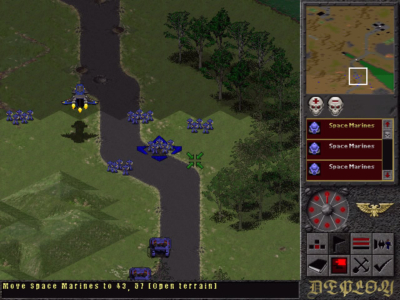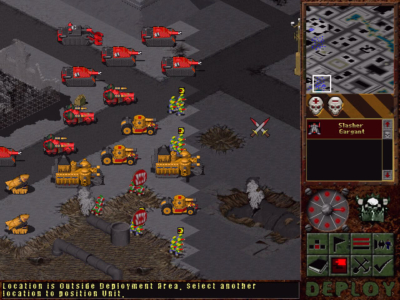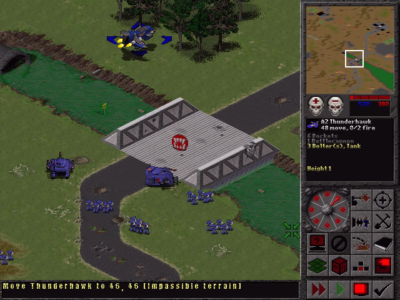
Final Liberation: Warhammer Epic 40,000
Written by: Stoo
Date posted: July 1, 2002
- Genre: Strategy
- Developed by: Holistic Design
- Published by: SSI
- Year released: 1997
- Our score: 7
In the 41st millennium, the Imperium of Mankind rules most of the galaxy. It is however beset on all sides by alien foes, forcing the vast armies of the Imperium to fight continuously for its survival. One these enemies is the Ork Horde, which has recently gone off on a rampage and captured the world of Volistad. It’s up to you as Lord Commander to reclaim this world for mankind.
Final Liberation is a turn-based strategy game, based on Games Workshop’s Epic 40k tabletop wargame. It’s set in a fascinating and detailed fantasy future universe; a rich tapestry of mythology, alien cultures, evil gods and techno-arcanery, amidst which the immense and totalitarian Imperium of Mankind barely qualifies as ‘good’ guys. Years ago I was an avid fan of Epic and it’s larger-scale brother Warhammer 40k. I remember being impressed with the detailed miniatures and comprehensive rules, and thought this must be what nerdy university students while away hours doing. Except now I’m a university nerd, and I can’t afford the overpriced miniatures and boxed sets. Oh well. I was finally tempted to buy Final Liberation when I saw it in a budget double-pack with the newer Chaos Gate (based on W40K). A software version would hopefully offer something similar to the gaming experience at a fraction the cost, although admittedly you don’t get the fun of collecting and painting your own army. Of course, I’m sure lots of Games Workshop fans have already snapped this one up and have their own opinions. What however of those who like a bit of strategy, but never got into tabletop gaming? For the purposes of this review I’ll endeavour to judge this game on its own merits.
There are two main ways to play Final Liberation; like most strategy games these days you can opt for a full campaign or a one-off battle. The quick battle is very similar to the tabletop game in format; choose your forces, line ’em up and let battle commence. There’s quite a bit of fun just in picking your forces: each unit type has a certain cost and you can spend up to a predefined limit. Obviously enough, a gigantic multiple-turreted tank is going to cost you more than a squad of hapless infantrymen.
One of Final Liberation’s definite strengths is the huge variety of units available on both the Ork and Imperial sides. The Imperium’s infantry are generally quite weak, but they also possess far better artillery so can start pounding enemy formations right from the start. They also access to some really monstrous super-heavy tanks that can take on three or four regular-sized tanks with ease. The Orks meanwhile have a wide range of cheap and fast bikes and buggies, while their tanks aren’t as well armed as their imperial counterparts but are on the whole cheaper. Where the arsenal really gets interesting though is when Titans get involved. These are huge bipedal Imperial war machines – imagine a mech but much bigger, with enough firepower to flatten waves of tanks. The Ork equivalent is the Gargant – a huge shambling land-going battleship, only vaguely humanoid in design. Add these behemoths to the mix and there’s enough to fulfil anyone’s fantasies of being a future general. You can choose to go all-out on titans, swamp the enemy with light units, or field a more mixed and flexible army.
With so much heavy weaponry rumbling around, you might think the poor hapless squaddies become entirely pointless. However, each weapon in the game has two stats – a strength and a “rate of fire” number. The former stat is more relevant to killing vehicles, whilst the latter is important against troops, and few weapons score highly in both. Think of it this way: if fifty soldiers were to run at you at once, would you want a huge armour-busting laser that’s insanely powerful but can only incinerate one person every ten seconds, or a light machine gun that can mow them down by the dozen? Weapons that can easily splat tanks are thus often fairly poor against infantry, and this means that while the little guys usually aren’t exactly a devastating force in battle, they’re not complete cannon-fodder either.
So now you have your forces ready, what’s it like down on the battlefield? Final Liberation uses a fairly solid turn-based engine. Most units can sit still and fire their weapons twice at anything they can see, move a little and fire once, or move further and forgo firing. If a unit has multiple weapon systems you can fire each cluster of guns separately. Meanwhile, if two opposing units end up adjacent they fight in close combat, where the computer basically roles an invisible die for each unit, adding their respective close assault ratings. This adds an extra dimension to combat, as most tanks are quite poor in close combat and so infantry and bikers can often gain the upper hand here.
ld.
Note however that there’s more to combat than merely killing things. At the start of battle you have a score based on how many active units youhaveatyour disposal. This will of course go down as you take casualties. However on each battlefield there are a couple of objectives on the map; these are locations you must capture. The score for both sides will drop in each turn they don’t have these objectives under their control, and the first player to reach zero loses that battle, even if they still have plenty of units still surviving. As it happens, during the campaign the Orks often have at least one objective under their control from the start of each battle. This lends a sense of urgency to the proceedings and means you’re really forced to take an active stance, forging ahead and risking casualties, rather than staying put and relying on your artillery.
Taking a look at the graphics, Final Liberation isn’t too exciting. The sprites are well detailed, but their animation is spartan at best. The limits become particularly apparent during a round of close assault, when each participant just kind of waves their arms, fires randomly and\or bobs up and down until one blows up. Also, the terrain looks a little flat and uninspiring. Except if you look a little closer, it does seem as if a lot of it is fashioned from styrofoam blocks, like the scenery an enthusiastic model-maker might create. So perhaps you need to approach this in the right frame of mind: the graphics are, not so much an unconvincing depiction of a war, but rather an accurate representation of a tabletop game. Taking the easy way out? Possibly, but then I imagine serious computer wargamers probably don’t regard graphics as a top priority anyway.
Apart from one-off battles, Final Liberation also features a fully fledged campaign where you take on the role of the imperial commander. Here you move your armies around Volistad on a map screen, which is divided into various regions. Again this is turn-based – with each passing turn every region you control generates resource points, which can be spent on buying new units or reinforcing existing units that have taken casualties. More regions under your command means more points coming in, so you have to decide whether to push forward to increase your income, or stay put and consolidate your forces to defend against possible ork counterattacks. It’s a simple but effective means of letting you conduct an overall strategy. Some may prefer a more in-depth approach to resource management (building factories, supply lines etc), but in Final Liberation the focus is primarily on directing battles.
To add a little atmosphere to your campaign, you’re subjected to the odd FMV sequence. In all honesty they’re cheap and cheerful… but not unduly cheap. I actually thought Commissar Holt, your right hand man and the main character of the film clips was quite well played. He’s a veteran soldier, eternally loyal to the Imperium and does his best to be respectful even when you’re on a losing streak. Meanwhile the special effects are a little grainy but often quite effective – especially in the scene where a Titan is reactivated. Overall the FMV sequences inject a much-appreciated dose of storytelling into the proceedings (and trust me, you can enjoy them even if you’re not familiar with the background to Epic 40k).
So now it’s verdict time. In short, looks quite basic and does nothing new or innovative, but it is a solid example of strategy gaming, and a successful conversion of the tabletop game. Yes, it’s an inescapable fact that this will have added appeal to Games Workshop fans, who in their enthusiasm can overlook the various flaws. However, Final Liberation should still appeal to the wider body of general strategy-heads too.





 Posts
Posts